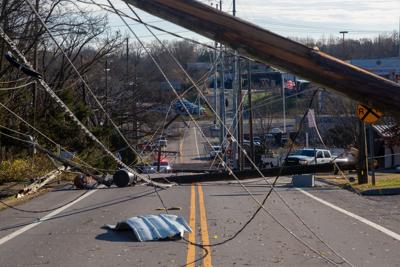Days after the storms, blue tarps are an easy way to know you’re getting closer to the damage. First they cover patches, then entire roofs. Neighborhood streets become thickets of downed trees, shattered glass, crushed vehicles, twisted trampolines and strewn possessions. Some houses are missing entire rooms or are leveled completely.
On Dec. 9, a tornado killed three people in Madison who had sheltered in their mobile homes. Three others died in Clarksville that day as a result of an early-December outbreak of tornadoes. The Federal Emergency Management Agency issued yet another disaster declaration for Tennessee, the state’s sixth this year.
For homes close to the storms’ epicenter, power outages became an ongoing threat, and power restoration is a critical step in the slow path back to normalcy. In the parking lot of the Madison Community Center, one family packs up food to replace what they lost in the days since their home was hit. John McMahon, whose Hendersonville home was hit, remembers sheltering in his house while winds whipped up to 125 mph outside — and the eerie flickering that followed the return of his home’s electricity.
“Everyone in the area was given an estimate of four or five days, but we got power back the next morning,” McMahon tells the Scene. ”We had internet, but I noticed the lights starting to flicker every few seconds. The [Nashville Electric Service] people came out and said, ‘If this was my house, I’d turn off the power and cut all the big appliances.’ Apparently the storm had ripped off the neutral connection.”
By Monday morning, McMahon (and his cat) could safely turn their electricity back on. A tarp is covering the hole in his house left by a fallen tree. Insurance claims come next.
NES addresses mass grid outages from the top down. Nashville buys power from the Tennessee Valley Authority, a government-chartered monopoly that serves much of the Southeast, and sells power to more than 400,000 customers in Middle Tennessee. Big metal towers run transmission lines from TVA power plants to local substations. Lines run out from substations down streets and through neighborhoods, gradually branching out to homes. Everything along that chain is vulnerable to extreme weather.
“We have to work to bring up the most people at one time,” explains Jose Fuentes, an NES customer service representative. “Substations can bring thousands of people back. Then distribution lines that run to secondary lines. Now it’s about individuals — individual sites that crews have to address one at a time.”
The day he speaks with the Scene, Fuentes is at the Madison Community Center talking with residents who have questions about when their power will return. He has access to the queue of work orders from NES’ central office downtown to help estimate when and where service will return next.
“Every storm, we learn something new,” says Fuentes. “We find something to improve how we do things.”
Northeastern Davidson County ends at Mansker Creek, but the NES service area extends past Hendersonville, where it shares a border with the Gallatin Department of Electricity. Nashville’s electrical grid took two huge hits on Dec. 9, leaving nearly 50,000 customers (about 10 percent of its total base) without power. Most outages came downstream of two substations knocked offline by direct hits.
Deaths include three residents of a small Madison mobile home park
These sites in Pennington Bend and Hendersonville immediately became top priorities for NES, says one employee who works on a bucket crew.
“You have to get to the subs first,” he tells the Scene. “That took us down to about 6,000 outages. The storm also took out a high transmission tower up by Saundersville, but that’s not us. We can’t touch it. It belongs to [the Tennessee Valley Authority].”
In moments of crisis, NES ramps up its capacity with out-of-state contractors, adding line workers to the city’s fleet of a few dozen bucket trucks. They fan out across the city based on directions from “Central” — employees who monitor the grid from the utility’s downtown headquarters. In 2022, NES launched a simplified version of its grid map online. From Dec. 9’s high of around 50,000 outages, viewers could see the total tick down Monday (5,000 without power) to Tuesday (3,700) to Wednesday (1,000) to Thursday (250) and Friday (75). These storms are a relatively tiny portion of NES’ work and budget, but they’ve thrust NES into the spotlight more frequently over the past few years. The utility’s disaster response — to tornadoes, winter storms and windstorms — headlined the utility’s 2023 annual report in late November.
NES will likely face these challenges again soon. Each weather event presents unique challenges, but each one drills an increasingly patterned response from the community, city, nonprofits and individuals. Recent weather analysis puts Nashville directly in a new Tornado Alley, caught beneath bigger, more extreme and more sudden swirls of hot and cold air — from the plains to Appalachia, amid humans’ ongoing disruption of climate patterns.
Based on viewership, many Nashvillians favor the volunteer weather watchers of Nashville Severe Weather over TV news. After facing criticism following the tornado outbreak for a lack of multilingual outreach efforts by the city, Mayor Freddie O’Connell appeared Friday with Tennessee Immigrant and Refugee Rights Coalition director Lisa Sherman Luna to discuss the city’s bilingual outreach efforts.
“We have learned since the 2010 flood how important it is to have systems, policies and practices that reach non-English speakers, because they are often the first hit, the worst hit, and are left behind in the relief and recovery process,” Sherman Luna told reporters. “It is clear we have work to do as a city to improve our systems. The reality is that extreme weather is on the rise and that Nashville is going to continue to face these natural disasters.”






